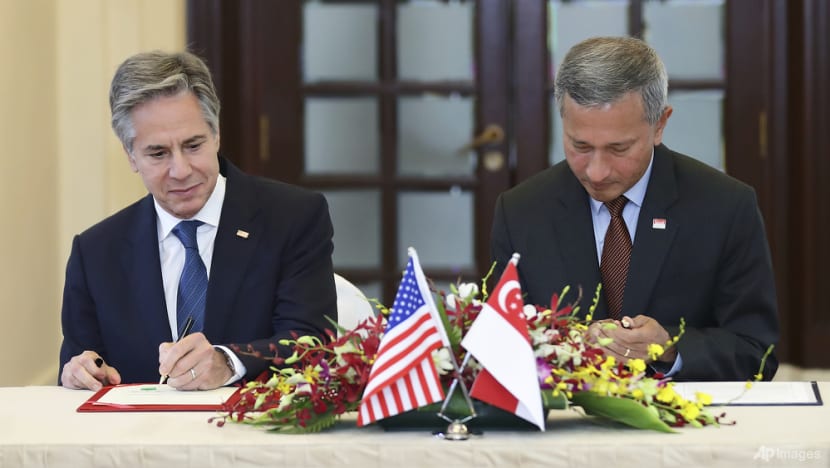CNA Explains: What Singapore’s ‘123 Agreement’ with the US means for its exploration of nuclear energy
US Secretary of State Antony Blinken and Singapore Foreign Affairs Minister Vivian Balakrishnan signed the civil nuclear cooperation agreement during Blinken’s official visit to Singapore.

US Secretary of State Antony Blinken and Singapore Foreign Affairs Minister Vivian Balakrishnan attend the signing ceremony for a 123 Agreement between the US and Singapore at Singapore's Ministry of Foreign Affairs on Jul 31, 2024. (Photo: AP/Suhaimi Abdullah)

This audio is generated by an AI tool.
SINGAPORE: Singapore still has not decided whether to deploy nuclear energy in the country, but signed an agreement with the United States as it continues to study ways to decarbonise its power sector.
Foreign Affairs Minister Vivian Balakrishnan and US Secretary of State Antony Blinken inked the civil nuclear cooperation agreement on Wednesday (Jul 31) during an official visit by Blinken to Singapore.
Also known as a “123 Agreement”, it will need to be reviewed by the US Congress before it comes into force. The agreement will last for 30 years once it kicks in.
What is a 123 Agreement, and why is it important?
When the US wants to conduct a significant nuclear export, the importing country must first sign an agreement stating that it will prevent the spread of nuclear weapons.
That is specified under Section 123 of the US’ Atomic Energy Act, which is how the agreements got their nickname.
At the signing ceremony, Dr Balakrishnan said the agreement facilitates access to information and technological expertise, and allows Singapore to engage more with civil nuclear experts in the US.
The agreement outlines a way to deepen peaceful nuclear cooperation between the US and Singapore based on a mutual commitment to nuclear non-proliferation, according to a joint statement by the US and Singapore governments.
Singapore can also get involved in other capacity-building initiatives such as the Foundational Infrastructure for the Responsible Use of Small Modular Reactor Technology (FIRST) programme.
The two countries intend to better understand how advanced nuclear energy technologies – including small modular reactors – can potentially support climate goals while balancing critical energy needs.
“This will support Singapore’s efforts to understand and evaluate advanced nuclear energy technologies, should viable options emerge,” the statement said.
How does it work for countries that sign one?
The US has 24 active 123 Agreements, including with countries such as China, India, Indonesia, Vietnam and the Philippines.
The agreements have to include nine non-proliferation criteria set out in Section 123 to guarantee that the partner countries use any information gained for peaceful purposes.
For example, nuclear materials must be physically secured and cannot be enriched, reprocessed or transferred without consent from the US.
Countries must also abide by the International Atomic Energy Agency’s standards on the use and security of nuclear material.
The Department of State’s website said such agreements set the foundation for collaboration with the US on nuclear energy as well as related educational and technological transfers.
A 123 Agreement with the US also allows Singapore to work with other countries that use nuclear technology originating in the US.
“This will allow us to work more closely with US institutions, as well as civil nuclear entities in other countries,” the Ministry of Sustainability and the Environment (MSE) and the Ministry of Trade and Industry (MTI) said in a factsheet.
“Such collaboration will facilitate Singapore’s capability-building journey.”
What does Singapore’s agreement mean for its stance on nuclear energy?
Singapore’s stance on nuclear energy has not changed with this agreement.
MSE and MTI said that Singapore has not made any decision about whether to deploy nuclear energy.
“Any deployment decision will require detailed studies of the safety, reliability, affordability and environmental sustainability of nuclear energy in our local context,” the ministries said in the factsheet.
It added that most designs of advanced nuclear reactors are still undergoing research and development, and have not begun commercial operations.
“Singapore is studying all potential options to decarbonise our power sector while maintaining our energy security and cost-competitiveness, as we work towards our target to achieve net-zero emissions by 2050,” the factsheet said.
But Singapore is open to considering collaborations with countries that can support its capability building in nuclear science and safety.
What are the concerns regarding 123 Agreements?
123 Agreements have faced opposition in countries such as India and South Korea.
Critics said India openly defied the Treaty on the Non-Proliferation of Nuclear Weapons (NPT), and the 123 deal with India violated the “spirit if not the letter” of the NPT, the late American sociologist Amitai Etzioni wrote in 2015.
The agreement also appeared to intensify the nuclear arms race between India and Pakistan.
Within India, there were concerns over threats to sovereignty and the possibility of the US having leverage over India.
In 2014, when a new agreement was being negotiated between the US and South Korea, the sticking point was uranium enrichment and spent-fuel reprocessing, according to an article by Duyeon Kim published by the Carnegie Endowment for International Peace.
The nuclear establishment in South Korea believed that capabilities in that area were critical for the country’s future as a consumer and exporter of nuclear energy, she wrote. But the US opposed it because the technology can be used to produce fissile material for nuclear weapons.
More recently, there have been concerns raised about a possible 123 Agreement with Saudi Arabia.
The kingdom wants the deal to include the construction of a uranium enrichment facility in Saudi Arabia by the US. But some in the US are concerned that it would lead to Saudi Arabia gaining nuclear weapons capabilities and an arms race in the Middle East.
















